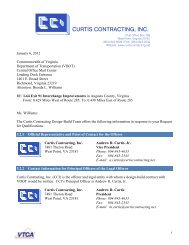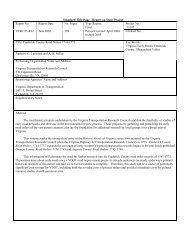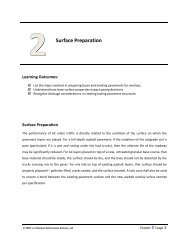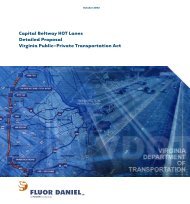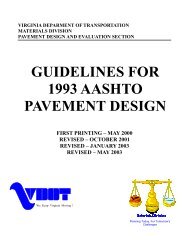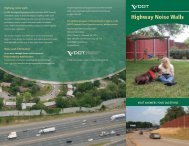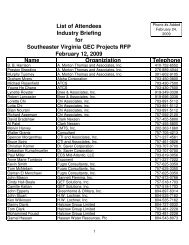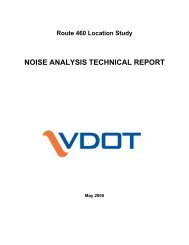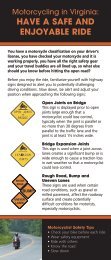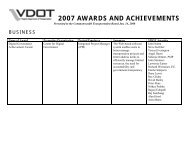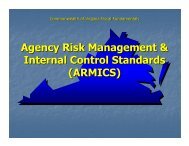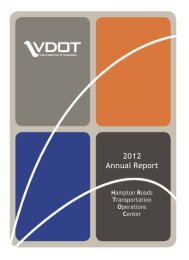Hampton Roads - Virginia Department of Transportation
Hampton Roads - Virginia Department of Transportation
Hampton Roads - Virginia Department of Transportation
Create successful ePaper yourself
Turn your PDF publications into a flip-book with our unique Google optimized e-Paper software.
<strong>Hampton</strong> <strong>Roads</strong> <strong>Transportation</strong> Operations Center<br />
2008 ANNUAL REPORT<br />
2008 was an exciting and successful year for the <strong>Hampton</strong> <strong>Roads</strong> <strong>Transportation</strong> Operations Center<br />
(TOC). Most significantly, VDOT completed the final phase <strong>of</strong> the <strong>Hampton</strong> <strong>Roads</strong> Traffic Management<br />
System (HRTMS); installing 71 cameras, 36 roadway detectors, and 22 changeable message signs. The<br />
project completion extended the TOC service area on I-64 further northwest—providing monitoring<br />
and response coverage for 113 total miles <strong>of</strong> interstate.<br />
Among other key changes and accomplishments over<br />
the past year, our name changed from the <strong>Hampton</strong><br />
<strong>Roads</strong> Traffic Management Center to the <strong>Hampton</strong><br />
<strong>Roads</strong> <strong>Transportation</strong> Operations Center. This name<br />
change resulted from an expansion <strong>of</strong> the TOC’s role in<br />
transportation operations and a more focused role in<br />
emergency response. We also conducted a hurricane<br />
preparedness exercise, and created and filled key<br />
positions, including a new Incident Management<br />
Coordinator. We adopted new procedures that improved<br />
the health and safety <strong>of</strong> our staff, provided thousands <strong>of</strong><br />
hours <strong>of</strong> training instruction to employees, and<br />
continued to reduce the average response time to assist<br />
during freeway incidents.<br />
The TOC’s expanded operations and achievements in<br />
2008 represent VDOT’s unwavering mission to provide<br />
superior service to motorists. Since assuming the role <strong>of</strong><br />
TOC Facility Manager last year, I witness daily the<br />
commitment <strong>of</strong> our entire staff to this mission. I hope<br />
you will enjoy reading about our past year’s work and<br />
the positive impacts we made, and will continue to<br />
make in <strong>Hampton</strong> <strong>Roads</strong>.<br />
Sincerely,<br />
Stephen Boyce<br />
Facility Manager<br />
Table <strong>of</strong> Contents<br />
2 HRTOC 2008 Performance Highlights<br />
3 Safety<br />
4 IT, Fleet, and Inventory Management<br />
5 Motorist Information<br />
7 Incident Response<br />
11 Field Equipment Maintenance<br />
13 Know Before You Go<br />
1
HRTOC 2008 Performance Highlights<br />
The <strong>Hampton</strong> <strong>Roads</strong> <strong>Transportation</strong><br />
Operations Center (HRTOC) consists <strong>of</strong><br />
two groups (Maintenance and<br />
Operations) and ten departments<br />
(Administration, Maintenance,<br />
Information Technology, Safety<br />
Service Patrol, Control Room, Fleet<br />
Management, Inventory Management,<br />
Training, Bridge Tunnel Operations,<br />
and Engineering Support). The<br />
departments work together to achieve<br />
fewer crashes and secondary crashes,<br />
decreased incident times, enhanced<br />
traveler information, and timely<br />
assistance to motorists.<br />
2008 Recaps<br />
• The Safety Service Patrol’s average<br />
response time to a vehicle crash<br />
was 8.4 minutes.<br />
• The Safety Service Patrol’s average<br />
clearance time <strong>of</strong> a vehicle crash<br />
was 37.5 minutes.<br />
• Control Room Operators responded<br />
to a daily average <strong>of</strong> 123.8<br />
disabled vehicle incidents.<br />
• There was a 23% increase—over<br />
71,556 events logged—in total<br />
Control Room responses compared<br />
to 2007.<br />
• 57% <strong>of</strong> all events were detected by<br />
the Safety Service Patrol; 24% by<br />
Closed-Circuit Television (CCTV)<br />
cameras.<br />
• The Safety Service Patrol drove<br />
2,886,775 miles, assisted 53,323<br />
motorists, and were first<br />
responders to 41,100 incidents.<br />
• The TOC Maintenance <strong>Department</strong><br />
completed 4,895 work orders,<br />
more than 3,000 <strong>of</strong> which were for<br />
facility or field device needs, with<br />
an average time <strong>of</strong> 5.14 hours from<br />
response to completion.<br />
• Each new employee received over<br />
135 training hours from the<br />
Training <strong>Department</strong>.<br />
• The Training <strong>Department</strong><br />
completed 100% <strong>of</strong> all annual<br />
safety training to TOC employees.<br />
Frequently Asked Questions<br />
Q: Do I have to pay for Safety Service Patrol assistance?<br />
A: The Safety Service Patrol program is a free service provided by VDOT.<br />
Q: Are there other <strong>Transportation</strong> Operations Centers in the Commonwealth?<br />
A: VDOT operates TOCs in <strong>Hampton</strong> <strong>Roads</strong> as well as Northern <strong>Virginia</strong>, Richmond, Staunton and Salem.<br />
Q: Does the TOC use traffic cameras to record events and accidents?<br />
A: The cameras are specifically used to detect incidents; we do not record or archive video <strong>of</strong> traffic events.<br />
Q: How do I arrange a tour <strong>of</strong> the HRTOC?<br />
A: We are always eager to share the TOC with civic, educational or service groups. Call 757-424-9903 or e-mail hamptonroadsinfo@VDOT.<strong>Virginia</strong>.gov to arrange a tour.<br />
Q: Is there more to the TOC than traffic management?<br />
A: The TOC goals are to reduce traffic congestion, as well as to improve traveler safety and provide up-to-date, reliable motorist information.<br />
This past year, in partnership with the <strong>Hampton</strong> <strong>Roads</strong> Metropolitan Planning Organization, the TOC led the Regional Concept <strong>of</strong> <strong>Transportation</strong> Operations (RCTO). The purpose <strong>of</strong> the<br />
RCTO is to develop collaborative solutions for regional highway incident management challenges.<br />
We also participated in the “Are you <strong>Virginia</strong>’s next traffic fatality?” statewide campaign focusing on safe driving habits. We are proud to say that there was a 27% reduction in statewide<br />
2<br />
highway fatalities in 2008, partly due to the campaign. We also participated in the annual statewide hurricane preparedness exercise, based on the plan for responding to a catastrophic<br />
event, such as a hurricane or homeland security threat.
Safety<br />
MAINTAINING SAFETY-ORIENTED AND WELL-TRAINED STAFF<br />
Key Accomplishments in 2008:<br />
• Developed the Bridge Tunnel Operations Training Manual, Bridge<br />
Tunnel Emergency Contact List, and the Health and Safety Action Plan<br />
• Developed Leadership and Accident Investigation Training for all<br />
supervisory personnel<br />
• Successfully maintained regulatory safety compliance<br />
• Participated in hurricane preparedness exercise<br />
Training and Safety<br />
The TOC has always focused on<br />
training to ensure employees are<br />
equipped with the skills and<br />
knowledge required to safely and<br />
efficiently perform their duties. The<br />
Training <strong>Department</strong> <strong>of</strong>fers formal<br />
training programs, certifications and<br />
structured classes. The Health and<br />
Safety Manager ensures all employees<br />
are equipped to perform their jobs in a<br />
safe and efficient manner.<br />
In 2008, the Training <strong>Department</strong><br />
provided over 9,000 training hours—<br />
more than 53 training hours, on<br />
average, per employee. Because the<br />
training is specific to transportation<br />
operations, all manuals and lesson<br />
plans were developed specifically for<br />
TOC personnel.<br />
The HRTOC Training <strong>Department</strong><br />
<strong>of</strong>fers formal training programs,<br />
certifications, and structured classes.<br />
The HRTOC also hired a Health and<br />
Safety Manager in 2008 to prepare a<br />
statewide Health and Safety Action<br />
Plan to address TOC operational<br />
safety issues. The statewide plan was<br />
localized for the <strong>Hampton</strong> <strong>Roads</strong> TOC<br />
and implemented by the Training<br />
<strong>Department</strong>.<br />
By creating a culture <strong>of</strong> safety, the<br />
TOC helped reduce the number <strong>of</strong><br />
Safety Service Patrol accidents in<br />
2008, which resulted in saving time<br />
and money.<br />
2008 Total Staff Hours <strong>of</strong> Training<br />
Executed, Quarterly<br />
3,215<br />
1,937<br />
2,338<br />
1,922<br />
Staff Hours<br />
Q1 Q2 Q3 Q4<br />
Accidents per 100K<br />
Miles Driven<br />
2007 and 2008 Ratio <strong>of</strong> Accidents per<br />
100,000 Miles Driven, Quarterly<br />
2.15<br />
1.8<br />
1.57<br />
1.23<br />
.91<br />
.69<br />
.63<br />
.29<br />
Q1 Q2 Q3 Q4<br />
2007<br />
2008<br />
3
IT, Fleet, and Inventory Management<br />
KEEPING THE HAMPTON ROADS TOC MOVING<br />
Key Accomplishments in 2008:<br />
• Replaced TOC network equipment to allow integration with VITA<br />
• Enhanced the Employee Training and Information Program (eTIP)<br />
• Completed the Information Technology Manual<br />
• Replaced nine vehicles and serviced dozens <strong>of</strong> vehicles to maintain<br />
Safety Service Patrol operations<br />
IT, Fleet, and Inventory<br />
Maintenance<br />
The TOC employs 176 full-time<br />
personnel, all requiring access to<br />
telephones and computer systems.<br />
The IT <strong>Department</strong>, which procures,<br />
installs and maintains all equipment<br />
and s<strong>of</strong>tware for the TOC, executed<br />
hundreds <strong>of</strong> work orders in 2008.<br />
Work ranged from performing simple<br />
repairs on malfunctioning systems to<br />
replacing network equipment for<br />
integration with the <strong>Virginia</strong><br />
Information Technology Agency<br />
(VITA).<br />
Service Patrol, which drove nearly<br />
three million miles last year alone rely<br />
heavily on their vehicles. In 2008, the<br />
Fleet Maintenance <strong>Department</strong><br />
maintained a high-level <strong>of</strong> available<br />
vehicles through effective preventative<br />
and corrective maintenance measures,<br />
and also replaced nine vehicles for the<br />
Safety Service Patrol to continue<br />
successful operations.<br />
89 <strong>of</strong> the 176 TOC staffers require<br />
vehicles to perform their on-the-job<br />
duties.<br />
All TOC employees require an<br />
inventory <strong>of</strong> goods to perform their<br />
job duties. Over half also depend on<br />
safe and reliable vehicles for traveling<br />
the interstate. In particular, the Safety<br />
2008 IT Tasks Completed<br />
2008 Vehicle Availability<br />
Routine<br />
Project<br />
Preventative<br />
Demand*<br />
Corrective<br />
1<br />
11<br />
110<br />
287<br />
521<br />
% <strong>of</strong> Availability<br />
84.8%<br />
97.9%<br />
99.7%<br />
Number <strong>of</strong> Tasks Completed by IT<br />
SSP Maintenance Pool*<br />
*Demand refers to an urgent request<br />
*Pool vehicles are general use vehicles provided for local travel by HRTOC Management.<br />
4
Motorist Information<br />
PROVIDING CRITICAL DATA TO HAMPTON ROADS MOTORISTS<br />
Key Accomplishments in 2008:<br />
• Implemented VaTraffic, which replaced the outdated VOIS system and integrated the HRTOC with other responders<br />
• Participated in VDOT Highway Safety Challenge through messaging and sign strategies<br />
• Expanded and enhanced the HRTOC Control Room s<strong>of</strong>tware (DYNAC ATMS) for improved operational reporting<br />
• Displayed ozone warning and AMBER Alert messages on changeable message signs to promote public health and<br />
support law enforcement<br />
Service Coverage<br />
The ultimate purpose <strong>of</strong> the HRTOC is<br />
to assist travelers in reaching their<br />
destination safely and quickly. A key<br />
element in fulfilling this purpose is to<br />
provide motorists with timely,<br />
accurate information on roadway<br />
conditions through the use <strong>of</strong><br />
sophisticated traffic management and<br />
communications equipment.<br />
I-64<br />
Phase 1<br />
Phase 2<br />
Phase 3<br />
The interim <strong>Hampton</strong> <strong>Roads</strong> Traffic<br />
Management System (HRTMS) began<br />
operation in 1992 using changeable<br />
message signs, access control gates,<br />
and the Safety Service Patrol in a<br />
limited area. Through completion <strong>of</strong><br />
the third phase <strong>of</strong> development in late<br />
2008, VDOT expanded the service<br />
area to 113 total interstate miles, and<br />
integrated CCTV surveillance,<br />
automated vehicle detection devices,<br />
and an incident management system.<br />
I-664<br />
I-564<br />
I-264 I-464<br />
I-64<br />
I-264<br />
74 Vehicle Detection<br />
Devices<br />
113 Miles <strong>of</strong> Safety Service<br />
Patrol Coverage<br />
6 Highway Advisory<br />
Radio Transmitters<br />
192 Changeable Message<br />
Signs<br />
270 CCTV Cameras<br />
Reversible Roadway<br />
Gates (5 Locations)<br />
5
MOTORIST INFORMATION<br />
Communication<br />
The HRTOC Control Room is the hub<br />
<strong>of</strong> communication for the HRTMS.<br />
Control Room Operators monitor the<br />
video feed <strong>of</strong> 270 cameras for<br />
incidents, crashes and roadway<br />
conditions. When adverse conditions<br />
exist, Operators relay this information<br />
to motorists through changeable<br />
message signs, Highway Advisory<br />
Radio (HAR) broadcasts, and the<br />
VDOT 511 information management<br />
system.<br />
VaTraffic is a web-based application<br />
used to manage operations and<br />
maintenance events across the<br />
Commonwealth. With data storage<br />
and reporting functionality, VaTraffic<br />
serves VDOT as a tool for monitoring,<br />
tracking, and assessing statewide<br />
operations and maintenance activity.<br />
Advancing the capabilities <strong>of</strong> its<br />
predecessor, <strong>Virginia</strong> Operational<br />
Information System (VOIS), VaTraffic<br />
facilitates the HRTOC Control Room’s<br />
input and management <strong>of</strong> event data<br />
which ultimately provides traveler<br />
information through the following<br />
sources:<br />
• 511 <strong>Virginia</strong> traveler information<br />
website<br />
• 511 <strong>Virginia</strong> Interactive Voice<br />
Response (IVR) telephone system<br />
• VDOT Dashboard website<br />
In addition to the traveler information<br />
service benefit, VaTraffic provides<br />
VDOT with regional and<br />
Commonwealth-wide awareness <strong>of</strong><br />
traffic incidents, congestion, road<br />
maintenance and weather events.<br />
After Control Room Operators enter<br />
event data into VaTraffic, they will<br />
<strong>of</strong>ten update data as an event<br />
progresses. These updates may<br />
include congestion delays, roadway<br />
closures, and incident clearing times.<br />
The graph to the right details the<br />
number <strong>of</strong> updates Control Room<br />
Operators entered into VaTraffic in<br />
2008, while the number <strong>of</strong> total<br />
reports per month is presented below.<br />
Maintenance being performed on a<br />
CCTV Camera positioned on a local<br />
cell tower<br />
2008 HRTOC Control Room<br />
Updates to VaTraffic, Monthly<br />
991<br />
1,679<br />
1,552<br />
1,445<br />
2,098<br />
1,991<br />
1,880<br />
2,391<br />
2,254<br />
2,940<br />
2,236<br />
1,817<br />
Jan<br />
Feb<br />
Mar<br />
Apr<br />
May<br />
Jun<br />
Jul<br />
Aug<br />
Sep<br />
Oct<br />
Nov<br />
Dec<br />
2,917<br />
4,167<br />
2007 and 2008 Traffic Events Broadcast<br />
Over HAR, Monthly<br />
2007<br />
2008<br />
2,762<br />
7,015<br />
4,415<br />
5,445<br />
3,765<br />
4,210<br />
4,511<br />
5,709<br />
5,686<br />
5,052<br />
4,460<br />
4,722<br />
5,944<br />
6,486<br />
4,128<br />
4,881<br />
5,158<br />
6,438<br />
5,335<br />
4,650<br />
3,966<br />
4,515<br />
361<br />
490<br />
2007 and 2008 VaTraffic Reports, Monthly<br />
333<br />
734<br />
512<br />
642<br />
492<br />
635<br />
458<br />
893<br />
629<br />
816<br />
538<br />
748<br />
709<br />
935<br />
485<br />
710<br />
541<br />
937<br />
621<br />
733<br />
524<br />
2007<br />
2008<br />
695<br />
Jan Feb Mar Apr May Jun Jul Aug Sep Oct Nov Dec<br />
Jan Feb Mar Apr May Jun Jul Aug Sep Oct Nov Dec<br />
6
Incident Response<br />
RESPONDING QUICKLY TO ASSIST MOTORISTS<br />
Key Accomplishments in 2008:<br />
• Employed an Incident Management Coordinator<br />
• All Safety Service Patrol staff members completed Level One<br />
Certification<br />
• Sustained increase in CCTV detection <strong>of</strong> events, from 11.1% in 2007, to<br />
24% in 2008<br />
HRTOC Control Room<br />
Incident Response<br />
Timely response to disabled vehicles,<br />
crashes, and other incidents are key to<br />
improving safety and congestion.<br />
Control Room Operators are able to<br />
pan, tilt and zoom 270 cameras and<br />
control over 190 changeable message<br />
signs throughout the <strong>Hampton</strong> <strong>Roads</strong><br />
interstate system.<br />
The HRTOC is able to detect events 24<br />
hours a day, seven days a week. In<br />
addition to HRTOC equipment, Control<br />
Room Operators also receive valuable<br />
information from the Safety Service<br />
Patrol, the public, and the <strong>Virginia</strong><br />
State Police Computer Aided Dispatch<br />
system (VSP CAD), to name a few. In<br />
2008 the HRTOC responded to 71,556<br />
events, a 23% increase over 2007.<br />
Once an incident is identified, a<br />
Control Room Operator is responsible<br />
for dispatching the Safety Service<br />
Patrol, notifying the public, and<br />
tracking event-related activity. The<br />
Operator records the type, location<br />
and assistance needed for the<br />
incident, the duration <strong>of</strong> the incident,<br />
and whether police, fire or rescue<br />
responders were present at the scene.<br />
Event Type<br />
Description<br />
Number <strong>of</strong><br />
Events<br />
AMBER / Ozone The HRTOC alerted motorists via Changeable<br />
Alert Message Signs<br />
11<br />
Vehicle Fire Vehicle fire that required extinguishing 229<br />
Special Event Concert, cultural event, etc. 197<br />
Maintenance Repairs and/or maintenance <strong>of</strong> HRTOC field<br />
Action equipment<br />
985<br />
Off Highway Incident on city street or arterial roadway 300<br />
Roadwork<br />
Stationary work zone, emergency<br />
maintenance, mobile lane closure, etc.<br />
4,253<br />
HOV Change<br />
Manual change made to the HOV Reversible<br />
Roadway by HRTOC<br />
1,944<br />
Other Police or medical emergency 1,337<br />
Choke Point<br />
The HRTOC assisted with congestion management<br />
at the HRBT, MMMBT, or Downtown Tunnel<br />
3,747<br />
Bridge Open<br />
A scheduled opening, an in-progress opening, or a<br />
malfunction <strong>of</strong> the Berkley Bridge, James River Bridge, 1,697<br />
Coleman Bridge, or High Rise Bridge<br />
Disabled Disabled vehicle 45,188<br />
Debris Ladder, mattress, furniture, etc., in the roadway 3,536<br />
Crash Vehicle collision 5,802<br />
Abandoned Abandoned vehicle 2,330<br />
2008 Events by Detection Source<br />
Control Room Operators dispatched Safety Service<br />
Patrol assistance within two minutes <strong>of</strong><br />
identification <strong>of</strong> all incidents in 2008.<br />
VSP CAD 3% (2,493)<br />
SSP 57% (41,100)<br />
Phone Call 13% (9,325)<br />
VATraffic 1% (384)<br />
VSP Radio 0% (217)<br />
Other 2% (1,158)<br />
CCTV 24% (16,879)<br />
7
INCIDENT RESPONSE<br />
Event duration, the time that passes<br />
from incident verification to incident<br />
clearance, has a pr<strong>of</strong>ound impact on<br />
motorist safety. Traffic events are<br />
estimated to cause nearly half <strong>of</strong> all<br />
traffic delays and, according to the<br />
Federal Highway Administration, 16%<br />
<strong>of</strong> all crashes occur as a result <strong>of</strong> a<br />
secondary collision—one resulting<br />
from a prior incident.<br />
To manage an incident, Control Room<br />
Operators first verify the incident<br />
through CCTV cameras, the <strong>Virginia</strong><br />
State Police Computer Aided Dispatch<br />
system, or other means. The Safety<br />
Service Patrol is then dispatched to<br />
the scene until the incident is cleared,<br />
or they are released.<br />
Incidents are defined as unplanned<br />
situations adversely impacting traffic<br />
flow such as crashes, debris, and<br />
disabled or abandoned vehicles.<br />
Events include everything from<br />
unplanned incidents, defined above,<br />
to planned “special events.”<br />
The HRTOC tracks incident duration<br />
for incidents lasting longer than 30<br />
minutes and longer than 60 minutes.<br />
Incidents lasting longer than 60<br />
minutes are generally more serious,<br />
and may require a post incident<br />
analysis, which involves a discussion<br />
between responding agencies to<br />
establish best practices for future<br />
coordination and response.<br />
2007<br />
2008<br />
2008 Average Traffic Incident Duration,<br />
in minutes<br />
8.7<br />
7.45<br />
Avg Response Time<br />
18.22<br />
20.27<br />
Avg Clear Time<br />
26.92<br />
Average Time<br />
from Verification<br />
to Clearance<br />
27.61<br />
Number <strong>of</strong> Events<br />
2008 Events Lasting Longer than 30 & 60 Minutes<br />
561<br />
170<br />
591<br />
180<br />
620<br />
184<br />
562<br />
215<br />
Dec 07<br />
Jan 08<br />
Feb 08<br />
Mar 08<br />
685<br />
273<br />
909<br />
Events >30 min<br />
412<br />
582<br />
320<br />
Apr 08<br />
May 08<br />
Jun 08<br />
883<br />
393<br />
1,131<br />
527<br />
816<br />
364<br />
Events >60 min<br />
1,027<br />
463<br />
799<br />
349<br />
796<br />
344<br />
Jul 08<br />
Aug 08<br />
Sep 08<br />
Oct 08<br />
Nov 08<br />
Dec 08<br />
8
INCIDENT RESPONSE<br />
Safety Service Patrol<br />
Assistance<br />
The Safety Service Patrol (SSP) is an<br />
integral part <strong>of</strong> the overall Traffic<br />
Incident Management strategy. The<br />
SSP program has evolved from basic<br />
motorist assistance into a full incident<br />
management and emergency response<br />
program. In addition to providing<br />
assistance to travelers, our SSP detect<br />
incidents and disruptions in traffic,<br />
minimize incident duration, clear<br />
obstruction and debris from the<br />
roadway, establish traffic control for<br />
emergency responders, and provide<br />
scene assistance as needed.<br />
The Safety Service Patrol assisted<br />
more than 53,000 motorists in 2008.<br />
The Safety Service Patrol monitor 113<br />
miles <strong>of</strong> interstate, driving 11 routes<br />
24 hours a day, seven days a week.<br />
Their trucks are specially equipped to<br />
service disabled vehicles, and to<br />
remove roadway obstructions as<br />
quickly as possible. In 2008, the<br />
Safety Service Patrol consistently<br />
responded to incidents within five<br />
minutes <strong>of</strong> dispatch, clearing most<br />
incidents in 30 minutes or less. In total<br />
for the year, the Safety Service Patrol<br />
assisted more than 53,000 motorists.<br />
2008 SSP Assists by Roadway<br />
2008 Types <strong>of</strong> SSP Assistance<br />
Arterial &<br />
Bridge/Tunnel<br />
I-664<br />
I-64<br />
I-564<br />
I-464<br />
I-264<br />
1,975<br />
1,170<br />
948<br />
847<br />
1979<br />
1613<br />
5,987<br />
6,108<br />
16,689<br />
15,923<br />
Number <strong>of</strong> Incidents<br />
2007<br />
2008<br />
27,263<br />
27,662<br />
Number <strong>of</strong> Assists<br />
4,163<br />
4,467<br />
Air<br />
1,199<br />
1.011<br />
440<br />
883<br />
Directions<br />
Flares<br />
5,717<br />
6,174<br />
Fuel<br />
82<br />
273<br />
1,457<br />
1,693<br />
887<br />
886<br />
512<br />
439<br />
Jack<br />
Jump Start<br />
Push<br />
6,281<br />
6,335<br />
5,387<br />
6,194<br />
1,269<br />
1,206<br />
Cell Phone<br />
Tire Change<br />
Tools<br />
Water<br />
2007<br />
2008<br />
9
INCIDENT RESPONSE<br />
Most Active Hot Spots<br />
They are known as “hot spots”:<br />
sections <strong>of</strong> roadway where the highest<br />
number <strong>of</strong> incidents occur. These<br />
areas receive special attention,<br />
whether it is through increased Safety<br />
Service Patrol coverage, concentrated<br />
transportation management, or<br />
alternative engineering. HRTOC hot<br />
spot data is used to facilitate studies<br />
<strong>of</strong> these problem areas, helping VDOT<br />
to provide safer interstates for<br />
motorists in <strong>Hampton</strong> <strong>Roads</strong>.<br />
I-64<br />
I-664<br />
I-564<br />
2008 Most Active<br />
<strong>Hampton</strong> <strong>Roads</strong><br />
Hot Spots<br />
The HRTOC uses four incident<br />
categories to determine hot spots:<br />
crashes, highway debris, disabled<br />
vehicles, and abandoned vehicles. In<br />
2008, the stretch <strong>of</strong> I-264 from<br />
Independence Boulevard to Rosemont<br />
Road represented the highest<br />
occurrence <strong>of</strong> incidents in all four<br />
categories in one location. The map to<br />
the right identifies key hot spots in<br />
<strong>Hampton</strong> <strong>Roads</strong> last year, along with<br />
the number <strong>of</strong> incidents per location.<br />
Debris Removal (178)<br />
Inside the Midtown Tunnel<br />
Crashes (312)<br />
64/264 Interchange –<br />
Northampton Boulevard<br />
I-264 I-464<br />
I-64<br />
Disabled Vehicles (1,985)<br />
Independence Boulevard –<br />
Rosemont Road<br />
I-264<br />
Abandoned Vehicles (97)<br />
Independence Boulevard –<br />
Rosemont Road<br />
10
Field Equipment Maintenance<br />
MAINTAINING A SOPHISTICATED SYSTEM<br />
Key Accomplishments in 2008:<br />
• Deployed hundreds <strong>of</strong> field devices (e.g., CCTV cameras, changeable<br />
message signs, roadway detectors) for completion <strong>of</strong> the final phase <strong>of</strong><br />
the HRTMS<br />
• Phased out embedded loop detectors and repaired remote traffic<br />
microwave sensors to support enhanced future traveler information<br />
services<br />
• Preserved uptime through severe weather events, including Hurricane<br />
Hanna, an electrical thunderstorm, and a nor’easter<br />
Field and Systems<br />
Maintenance<br />
Roadway conditions can change<br />
rapidly, and incidents can occur in the<br />
blink <strong>of</strong> an eye. The TOC relies on<br />
hundreds <strong>of</strong> field devices to facilitate<br />
quick and accurate incident<br />
identification for immediate response,<br />
as well as timely relay <strong>of</strong> information<br />
to motorists. It is this urgency that<br />
makes the Maintenance <strong>Department</strong><br />
such a critical part <strong>of</strong> the HRTOC.<br />
field equipment; all <strong>of</strong> which comprise<br />
the HRTMS. Devices are assigned a<br />
priority level for service based on<br />
safety requirements. For example,<br />
HOV reversible roadway gates and<br />
their associated devices are rated<br />
“priority one” based on their critical<br />
importance.<br />
2008 Average Maintenance<br />
Times by Priority, in hours<br />
2006<br />
2007<br />
2008<br />
3.8<br />
2.5<br />
2.4<br />
8.3<br />
6.1<br />
7.9<br />
26<br />
17.6<br />
22.4<br />
Priority 1 Priority 2 Priority 3<br />
The Maintenance <strong>Department</strong> is<br />
responsible for the repair and<br />
maintenance <strong>of</strong> over 270 CCTV<br />
cameras, hundreds <strong>of</strong> message signs,<br />
dozens <strong>of</strong> gate controls, and other<br />
2008 Corrective Maintenance by Device Type<br />
Device Availability for 2007 and 2008<br />
CMS (399)<br />
Gates (140)<br />
HAR (41)<br />
DET (40)<br />
BLDG (61)<br />
Projects (68)<br />
99%<br />
98%<br />
90% 89%<br />
100%<br />
98% 99% 96%<br />
70%<br />
90%<br />
2007<br />
2008<br />
CCTV (422)<br />
CCTV CMS Gates HAR Detector<br />
Stations<br />
11
FIELD EQUIPMENT MAINTENANCE<br />
Field and Depot Maintenance<br />
Preventative maintenance allows the<br />
HRTOC to identify hidden problems,<br />
prevent device failures, and reduce<br />
the need for corrective maintenance<br />
and equipment downtime. In 2008,<br />
the Maintenance <strong>Department</strong><br />
completed 1,874 preventive tasks. The<br />
HRTOC also implemented an improved<br />
preventative maintenance schedule<br />
that details device locations and<br />
scheduled service dates.<br />
The depot sector <strong>of</strong> the Maintenance<br />
<strong>Department</strong> is responsible for<br />
performing repairs and maintenance<br />
on all electronic equipment, such as<br />
chips, resistors, capacitors, etc. This<br />
service becomes increasingly<br />
important as equipment ages and<br />
replacement parts become<br />
unavailable. In 2008, the depot sector<br />
<strong>of</strong> the Maintenance <strong>Department</strong><br />
performed nearly 500 repairs.<br />
2008 Preventative Maintenance by Device Type<br />
2008 Depot Level Repairs, by quarter<br />
147<br />
CCTV (479)<br />
CMS (360)<br />
120<br />
113<br />
89<br />
BLDG (191)<br />
Gates (43)<br />
HAR (74)<br />
DET (727)<br />
Q1 Q2 Q3 Q4<br />
12
Know Before You Go<br />
Check traffic conditions before you hit the road. To avoid congestion, use these Know Before You Go<br />
information resources to check roadway conditions in <strong>Hampton</strong> <strong>Roads</strong>:<br />
www.Va511.org<br />
View traffic cameras, set up e-mail and text alerts, learn<br />
about road construction and bridge lifts, and more, all at<br />
one convenient web location.<br />
CMS<br />
Changeable Message Signs are strategically located<br />
throughout the interstate system. Watch them for<br />
current and changing roadway conditions.<br />
HAR Radio, 610 AM<br />
Tune into Highway Advisory Radio at 610 on your AM<br />
radio dial. Incidents, roadway conditions and<br />
congestion reports are broadcast as they occur. If you<br />
are out <strong>of</strong> the broadcast area, call the TrafficLine at 757-<br />
361-3016, which also transmits the HAR reports.<br />
CITIZEN COMMENTS<br />
“What a life saver! This is an<br />
extraordinary service you provide<br />
and I am truly thankful.” – Emily H.<br />
“(The SSP driver) was very friendly as well<br />
as helpful. If this is what my taxes pay for<br />
then I am truly happy.” – Curtis S.<br />
“The gentleman was very<br />
courteous, helpful and safe. He<br />
made this whole situation much<br />
more bearable.” – Nicholas G.<br />
“I'm very thankful for the help I received.<br />
They took care <strong>of</strong> everything for me in a<br />
courteous and pr<strong>of</strong>essional manner. This is<br />
a great service.” – James H.<br />
“(The SSP driver) was very courteous and friendly. He<br />
helped me in a timely manner which was nice because <strong>of</strong><br />
how cold it was. I have never had to use SSP service before,<br />
but I'm very glad its available when needed.” – Lucy M.<br />
“As a senior citizen with arthritis and back problems, this service was greatly<br />
appreciated as I didn't have my cell phone. I was really thankful.” – Edward C.<br />
“We ran out <strong>of</strong> gas on the highway. SSP saw us and<br />
pulled over less than 5 minutes later. They gave us<br />
gas and told us where the nearest gas station was<br />
and we were on our way 5 minutes later… They<br />
were guardian angels. Thank you!” – Lauren S.<br />
“I am new to the area and don't have support or<br />
family. Knowing this type <strong>of</strong> assistance is available<br />
makes me feel so safe. Thank you!” – Anita B.<br />
“Your driver was exceptionally courteous and<br />
helpful. Being from out <strong>of</strong> state I am very pleased<br />
with the service. I am also very grateful. Thank<br />
you.” – Josh N.<br />
13



